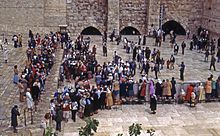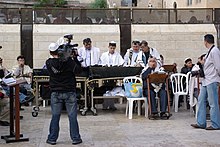Bar Mitzvah

Bar Mitzvah or Bar Mitzvah (from Aramaic בַּר 'son' and Hebrew מִצְוָה 'commandment'), for girls bat mitzvah or bat mitzvah (Hebrew בַּת מִצְוָה, daughter of the commandment) denotes religious maturity in Judaism . Boys reach it at the age of thirteen, girls at the age of twelve. Bar and Bat Mitzvah denote the status as well as the day and the celebration on which religious maturity occurs.
basis
The basis is the legal regulation according to Jewish law on the point in time from which a boy is responsible for observing and observing the Jewish commandments ( mitzvot , singular mitzvah ). This rite of passage goes hand in hand with physiological puberty . From then on, the bar mitzvah or bat mitzvah may or must perform all religious tasks, such as reading from the Torah in the synagogue . This also includes the application of tefillin , i.e. H. Leather capsules that contain Torah passages on parchment and are attached to the hand and head with leather straps.
Other spellings

The Hebrew parts of the term can be transcribed in German in different ways . Mitzvah can also be written as Mitzva (h) or Mitzvah (h) , Bat also as Bas . The Duden suggests the spelling Bar / Bat-Mitzvah. The masculine plural form is B'nei Mitzva (sons of duty), the female B'not Mitzva (daughters of duty).
historical development
Originally, it was a legal status that the boy had reached and was bound to physical maturity. This young person was therefore only called Gadol (adult) or Bar Onuschin (son of punishment = someone who is responsible for his actions) in earlier sources . The expression bar mitzvah (son of duty) in the sense commonly used today can be found for the first time in Mordechai ben Hillel , a rabbi and liturgical poet who was murdered in Nuremberg during the rintfleisch pogrom in 1298 . From the 14th century onwards, the bar mitzvah celebration prevailed.
Bar and Bat Mitzvah - the day of assuming duty
The tradition has developed that on this day the young people learn to recite the Hebrew (non-vocalized) Torah section and the Haftara , the reading from the books of the prophets. This "first Torah call ", usually Maftir , the section of the person who also reads the Haftara, is solemnly celebrated, and the boy or girl is accepted into the community on this feast day, usually on the Sabbath after the 13th Birthday of the male or after the 12th birthday of the female youth, and for the first time fully included in the service .
In reform congregations , in contrast to Orthodox Jewish congregations , girls are allowed to read the Torah just like boys. The bat mitzvah for girls, although dating back to an older custom, did not gain general acceptance in reforming churches until the 20th century. The bat mitzvah of the daughter of Mordecai Kaplan , the founder of reconstructionism, is known in 1922 . Girls at the Rykestrasse synagogue in Berlin have been Bnot Mitzvahs since the mid-1920s .
Bar Mitzvah and Bat Mitzvah celebrations
After the service, a snack, called a kiddush , donated by the parents of the bar or bat mitzvah, is served for all participants in the service. In the evening or the next day, the actual festival takes place, in which several hundred invited guests often take part.
Web links
- Bar and Bath-Mitzvah on the festival of religious maturity
- A meaningful Bat Mitzvah celebration
- Bar & Bat Mitzvah Growing Up
- Article about a bar / bat mitzvah exhibition in Basel: Time of coming of age
Individual evidence
- ↑ Bar Mitzvah . In: Wissenschaftlicher Rat der Dudenredaktion (Hrsg.): Duden: The German orthography . 24th edition. tape 1 . Dudenverlag , Mannheim 2006, ISBN 978-3-411-04014-8 , pp. 229 , col. 1 .
- ↑ Bat Mitzvah . In: Duden: The German spelling . S. 231 , col. 1 .
- ^ Zvi Kaplan, Norma Baumel Joseph: Bar Mitzvah, Bat Mitzvah. In: Encyclopaedia Judaica. Volume 3. Macmillan Reference USA, Detroit, 2007, pp. 164-167 , accessed March 29, 2012 .
- ^ Hermann Simon , The Synagogue Rykestrasse (1904–2004) , Berlin: Hentrich & Hentrich and Stiftung Neue Synagoge Berlin / Centrum Judaicum, 2004, (= Jewish miniatures; vol. 17), p. 18. ISBN 3-933471-71- 0
